Tarot Cards For Beginners First Step
Just initiateing on your journey with tarot cards can be both exciting and daunting. In this guide, you will discover eight vital steps that will help you improve your readings and deepen your connection with the cards. Whether you’re looking to gain insights into your personal life or develop your intuitive skills, each step is designed to enhance your understanding and confidence. Dive in and unlock the mystical wisdom that tarot offers!

Key Takeaways For Tarot Cards For Beginners:
- Get familiar with the basics of tarot, including the meanings of each card and the structure of the deck.
- Practice daily card draws to build your intuition and deepen your understanding of the cards.
- Develop a dedicated space for readings to create a calming environment that enhances your focus.
- Use a tarot journal to track your readings, interpretations, and any patterns that emerge over time.
- Explore different tarot spreads to find those that resonate with you and suit various questions or situations.
- Trust your instincts and interpretations, allowing your personal insights to guide your readings.
- Connect with other tarot enthusiasts through classes, workshops, or online forums for shared learning and growth.
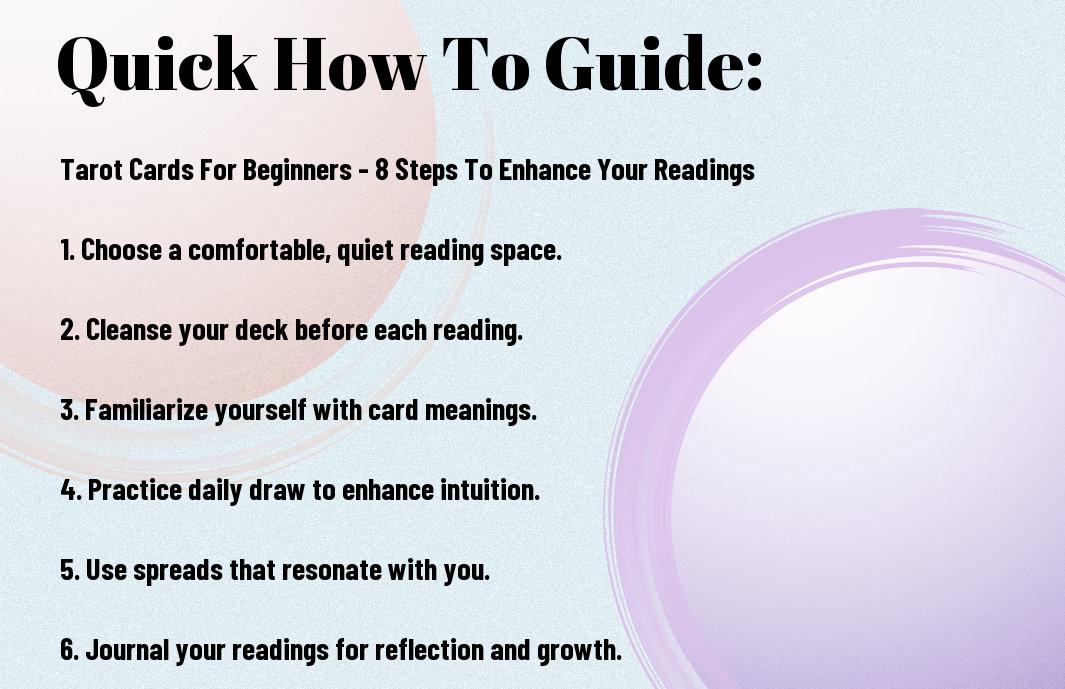
Understanding Tarot Cards For Beginners Basics
The Tarot is a powerful tool for divination and self-reflection. Each card in the deck holds unique meanings and can guide you through various aspects of life. To begin your journey, it’s crucial to familiarize yourself with the basic components of Tarot, including its structure and the different types of cards that make up the deck. With this foundational knowledge, you can build deeper insights into your readings.
Types of Tarot Decks
The world of Tarot decks is vast and diverse. You will encounter various styles and themes, each with unique artwork and symbolism to explore. Here are some common types:
- Traditional Tarot – Classic decks, such as the Rider-Waite.
- Oracle Cards – Free-form decks with varying themes.
- Lenormand Cards – Focus on everyday situations.
- Historical Decks – Vintage decks steeped in history.
- Themed Decks – Unique art styles like fantasy or spiritual.
Assume that selecting a deck that resonates with your intuition can significantly enhance your connection to your readings.
| Type of Deck | Description |
| Traditional Tarot | Includes crucial archetypes and symbols. |
| Oracle Cards | Flexible interpretations based on themes. |
| Lenormand Cards | Focuses on practical, everyday readings. |
| Historical Decks | Showcases tarot’s rich lineage and development. |
| Themed Decks | Art that reflects specific interests or beliefs. |
Card Meanings and Symbolism
Meanings of Tarot cards vary widely based on context and intuition. Each card features layers of symbolism designed to evoke insights into your queries. Learning these meanings allows you to interpret cards accurately, regardless of position in a spread.
Another important aspect of Tarot is understanding the symbolism behind each card. Each card carries positive, negative, and even dangerous connotations, depending on how you interpret them within your reading. The imagery, colors, and elements present in a card can provide additional layers to your interpretation. As you practice, pay attention to how certain symbols resonate with you personally, as this can lead to more insightful and meaningful readings.
Preparing for Your Reading
There’s a significant impact when you take the time to prepare for your tarot reading. With a clear mind and an intentional approach, you can create a more meaningful connection with the cards. This preparation sets the stage for a deeper understanding of the insights they provide, allowing you to engage with both your intuition and the messages unfolding before you.
Creating Sacred Space
With your environment in mind, establishing a sacred space is important. Take a moment to find a quiet area where you feel comfortable and inspired. You might light a candle, burn incense, or even play soft music to elevate the atmosphere. This intentional act helps you focus and aligns your energy with the reading, enhancing the clarity of your insights.
Cleansing Your Deck
Cleansing your tarot deck is vital for maintaining its energetic purity. This step helps you eliminate any lingering negative energies that may affect your readings, allowing your intuition to flow freely. You can periodically cleanse your cards through methods like smudging with sage, placing them under moonlight, or using crystals to charge them with positive vibrations.
A variety of cleansing techniques can be beneficial for your tarot deck. Smudging with sage is a popular choice, as the smoke is believed to purify and dispel negativity. Alternatively, placing your deck in the moonlight overnight can recharge your cards, aligning them with lunar energies. If you prefer using crystals, consider placing your deck on a selenite or clear quartz crystal; both are known for their purifying properties. Ensure you choose a method that resonates with you, as this personal connection enhances your tarot practice.
Essential Reading Techniques
For a successful tarot reading, mastering necessary techniques is key. These methods not only enhance your skills but also deepen your connection with the cards. Practicing consistently and developing your intuition will result in more insightful readings, allowing you to tap into the wisdom of the tarot. You’ll find that honing these techniques leads to greater clarity and accuracy, empowering you to provide meaningful guidance for yourself and others.
Shuffling Methods
Assuming you’re ready to engage with your tarot deck, the way you shuffle the cards can significantly influence your readings. Various techniques, such as overhand or riffle shuffling, help to mix the energies within the deck. You may prefer to shuffle intuitively, allowing your intuition to guide you in how long to shuffle or if you should cut the deck. Your personal connection with the cards is vital, so choose a method that feels comfortable and resonates with you.
Spreads for Beginners
On your tarot journey, starting with simple spreads can greatly benefit your understanding of the cards. Popular spreads, like the three-card spread or the Celtic Cross, provide a structured way to interpret the messages the tarot has for you. Utilizing these layouts allows you to focus on specific questions and themes, which can enhance your analytical skills. Choose a spread based on your experience level and the depth of understanding you seek.
It’s vital to select spreads that align with your intuition and current situation. The three-card spread is perfect for beginners, as it easily represents the past, present, and future. With the Celtic Cross, you can examine deeper into specific aspects of your life, drawing insights from ten different card positions. By experimenting with various layouts, you’ll discover effective ways to interpret the tarot’s messages, and over time, you will develop greater familiarity with the cards, enhancing your overall reading experience.
Developing Intuition
All tarot readers strive to deepen their intuitive abilities, as intuition is the cornerstone of effective readings. By trusting your gut feelings and innate insights, you can unlock deeper meanings in your cards and enhance your connection to the spiritual realm. Developing your intuition takes practice and patience, so embrace the journey of understanding your inner wisdom and let it guide your tarot experiences.
Meditation Practices
The practice of meditation can significantly improve your intuitive skills, providing you with mental clarity and focus. Set aside a few minutes each day to meditate, allowing your thoughts to settle and your mind to open up. This quiet time helps create a channel for intuitive messages and strengthens your ability to connect with the energies of your tarot cards.
Connecting with Your Cards
If you want to strengthen your bond with your tarot deck, it is necessary to establish a personal connection. Spending time handling your cards, studying their imagery, and reflecting on their meanings will create a relationship that deepens your readings.
A strong connection with your tarot cards can lead to powerful insights during your readings. Hold your cards regularly, allowing their energy to flow into you and vice versa. Consider conducting a ritual before each reading, such as cleansing the deck with sage or simply focusing on your intention for the session. The more you interact with your cards, the more your intuition will grow, leading to profound and meaningful experiences during your readings. Building this connection is key to unlocking the many layers of interpretation that each card has to offer.
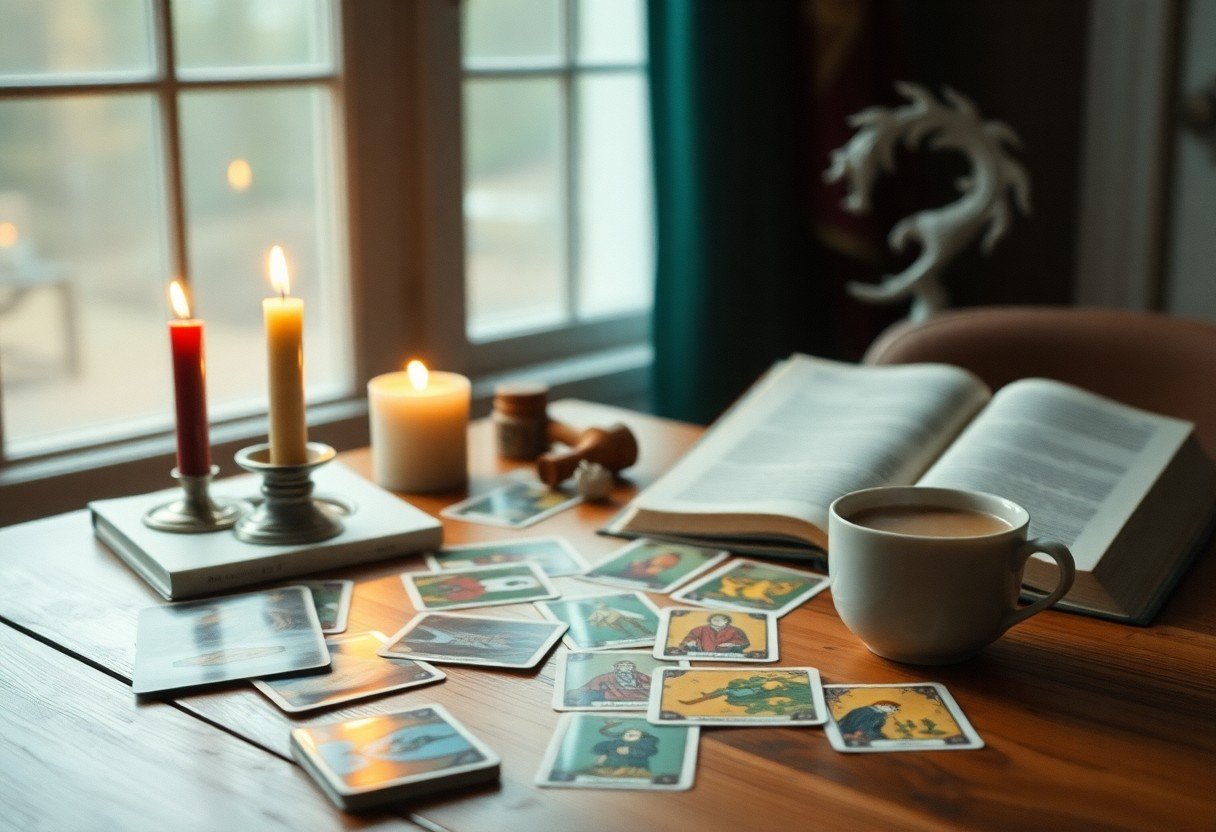
Common Reading Mistakes
To improve your Tarot readings, it’s vital to avoid common mistakes that can lead to confusion or misinterpretation. Many beginners overlook the importance of grounding their approach, leading to inaccurate insights. By familiarizing yourself with the fundamentals of Tarot reading, you can enhance your skills. For a comprehensive guide, check out How to Read Tarot Cards: A Step by Step Guide.
Interpretation Errors
On occasion, you may misinterpret card meanings based on personal bias or emotional state. It’s crucial to approach each reading with an open mind, allowing the card’s message to unfold naturally, rather than projecting your feelings onto the cards.
Reading Boundaries
Now, establishing clear boundaries during a reading can greatly influence the outcome. You should clarify your intentions and respect the limits of your readings to maintain an ethical practice. This ensures you are not overstepping by offering advice on matters that require professional expertise.
Interpretation of your reading boundaries helps protect both you and the querent, fostering a safe space for shared insights. By emphasizing ethical practices and understanding personal limitations, you’re more likely to yield positive outcomes. Additionally, ensure you provide guidance without crossing into areas that can cause harm or misguidance, respecting the depth and seriousness of the questions posed.

Building Your Practice
Despite initial uncertainties, establishing a consistent tarot practice will greatly enhance your readings and deepen your intuition. By dedicating time to the cards and working with them regularly, you’ll develop a stronger connection and understanding of their messages. Create a routine that suits your lifestyle, whether it’s a weekly ritual or daily engagement, and allow your practice to evolve naturally.
Daily Card Draws
Any morning can become a meaningful start by drawing a daily card. This simple exercise prompts you to focus on the card’s message and how it may relate to your day ahead. It encourages reflection and sets a tone for your thoughts and actions, solidifying your connection to the tarot.
Keeping a Tarot Journal
Clearly documenting your tarot journey in a journal can offer valuable insights and personal growth. By recording your readings, interpretations, and feelings, you build a personalized resource that allows you to track patterns over time, aiding in your development as a reader.
Building a tarot journal serves as a reflection tool that helps you analyze your intuitive responses and understanding of the cards. You might chart your daily draws, note how they corresponded with events, or reflect on your evolving interpretations. Over time, this practice can reveal themes in your life and enhance your ability to connect with the cards. The act of writing can also confirm your thoughts and feelings, making it easier to develop your voice as a reader.
Advanced Reading Tips
Unlike beginner readings, advanced tarot insights can profoundly influence your interpretation. Here are some strategies to refine your skills:
| Tip | Description |
|---|---|
| Trust Your Intuition | Allow your gut feelings to guide your interpretations. |
| Consider Reversals | Explore the meanings when cards appear upside down. |
| Ask Specific Questions | Narrowing your focus can lead to clearer insights. |
| Use Spreads Wisely | Experiment with various layouts for different inquiries. |
| Document Your Readings | Keep a journal to track your progress over time. |
Combining Cards
Little nuances can emerge when you analyze how cards interact with one another. Look for major themes that arise from combinations and reflect on how their energies play off each other. This synergy often reveals deeper insights into your readings.
Timing in Readings
Some tarot practitioners place significant emphasis on timeframes, believing certain cards can indicate timelines related to the questions posed. Understanding the nature of cards can help in determining if an event is near or farther away in the future.
The Major Arcana often signifies significant life events and could indicate longer timelines, while Minor Arcana cards could suggest shorter durations. For example, the Page of Wands may hint at events unfolding within a few weeks, whereas the Wheel of Fortune may point to substantial shifts occurring over several months. Being aware of these visual indicators can enhance your readings, guiding you toward how quickly change may come, and helping you manage expectations appropriately.
Final Words
From above, you can see that mastering tarot readings involves a blend of intuition, practice, and understanding. By following these 8 steps, you can enhance your readings and forge a deeper connection with the cards. Each step offers an opportunity to refine your skills, allowing you to interpret the messages the tarot conveys more effectively. Embrace this journey, cultivate your connection with the cards, and watch as your readings transform into insightful reflections of your own and others’ journeys.
Tarot Cards For Beginners FAQ
Q: What are Tarot cards and how do they work?
A: Tarot cards are a deck of 78 cards used for divination, self-reflection, and guidance. Each card has unique imagery, symbolism, and interpretations. When drawn during a reading, the cards work together to convey messages related to the querent’s inquiry, revealing insights about their past, present, and potential future.
Q: What do I need to get started with Tarot reading?
A: To start reading Tarot, you will need a Tarot deck that resonates with you, a quiet space for reflection, and a notebook to jot down your thoughts and readings. It’s also beneficial to familiarize yourself with the meanings of each card and different Tarot spreads, which help structure your readings.
Q: What are the 8 steps to enhance my Tarot readings?
A: The 8 steps to enhance your Tarot readings are: 1) Set a clear intention before starting. 2) Choose a deck that speaks to you. 3) Learn the meanings of the cards. 4) Practice different spreads. 5) Connect with your intuition. 6) Keep a Tarot journal to track your readings. 7) Reflect on your emotions and thoughts during readings. 8) Seek feedback from others to improve your skills.
Q: How can I interpret the Tarot cards effectively?
A: To interpret Tarot cards effectively, focus on the imagery, symbols, and positions of the cards in the spread. Trust your intuition, as personal insights often provide deeper meanings. Look for connections between the cards and relate them to the question or situation at hand. Continuous practice and study will also enhance your interpretative skills.
Q: Is it necessary to memorize card meanings?
A: While memorizing card meanings can be helpful, it is not strictly necessary. Many readers find it more beneficial to understand the overall themes and emotions of each card and rely on their intuition during readings. Over time, you will naturally become more familiar with the meanings as you engage with your deck.
Q: Can I do Tarot readings for others as a beginner?
A: Yes, beginners can certainly do Tarot readings for others! Begin with close friends or family who are supportive. Explain that you’re still learning, and invite them to engage with the process. This can help build your confidence and provide valuable feedback on your readings.
Q: How often should I practice with Tarot cards?
A: Practicing regularly is key for improvement. You can start with daily or weekly readings for yourself, gradually increasing the frequency as you grow more comfortable. The more you engage with the cards and reflect on your experiences, the stronger your connection and interpretation skills will become.



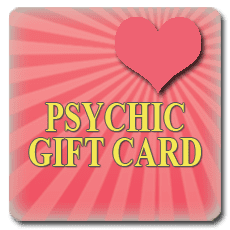
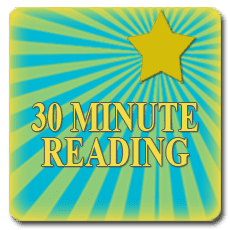
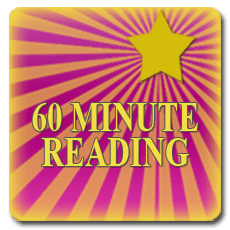

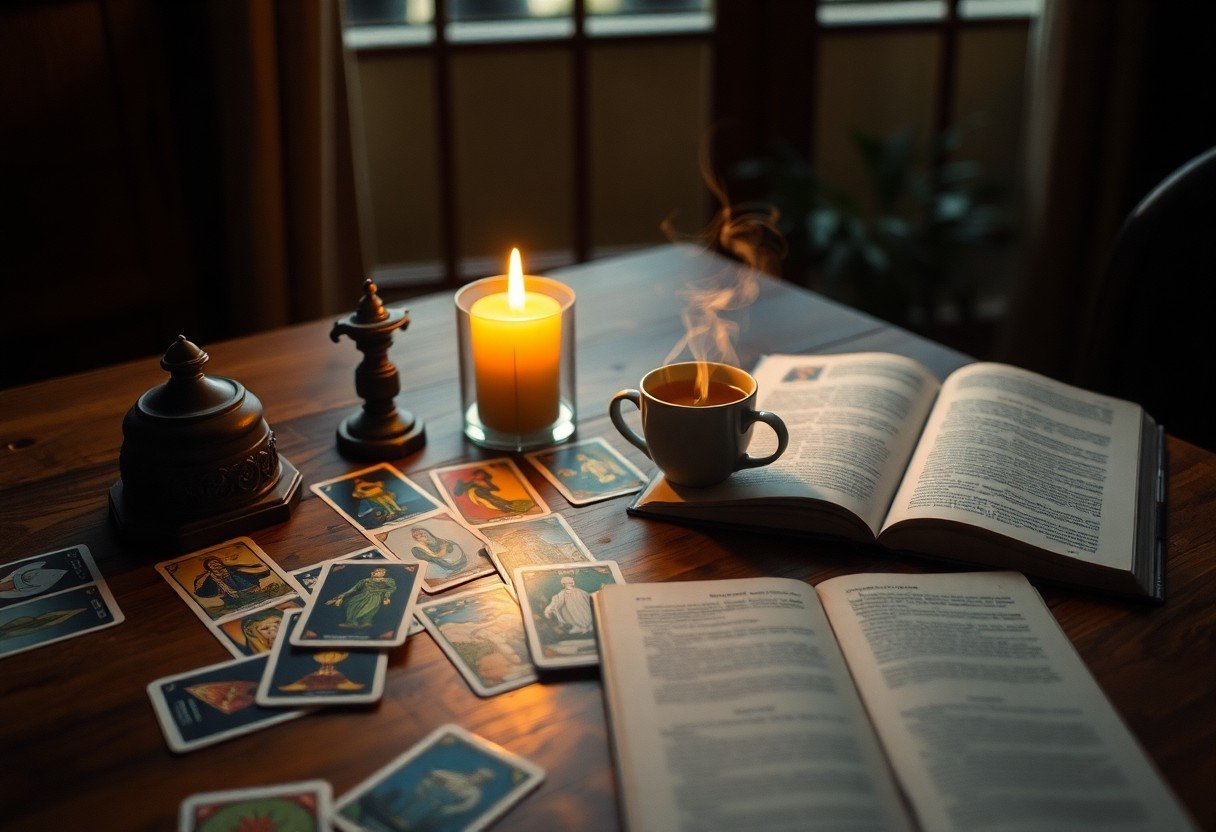
0 Comments